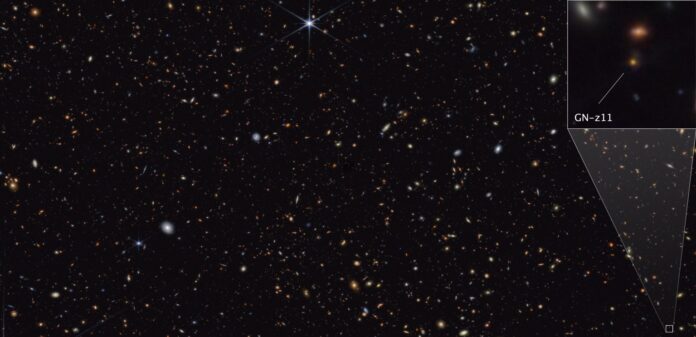Two astronomy research teams have examined space and time in great detail using NASA’s James Webb Space Telescope. They discovered the first concrete proof that the bright galaxy GN-z11 is home to a central supermassive black hole that is accreting matter at a rapid pace. This is the most distant supermassive black hole observed in the Universe.
When our Universe, which is 13.8 billion years old, was roughly 430 million years old, GN-z11 was born. Among the youngest and furthest ones ever seen, it is. Its brightness defies the comprehension of astronomers.
The most recent study now reveals some of its mysteries.
Principal investigator Roberto Maiolino of the Cavendish Laboratory and the Kavli Institute of Cosmology at the University of Cambridge in the United Kingdom said, “We found extremely dense gas that is common in the vicinity of supermassive black holes accreting gas.”
“These were the first clear signatures that GN-z11 is hosting a black hole that is gobbling matter.”
The black hole is actively eating stuff at a mass of two million solar masses, which explains why it is so luminous.
In addition, the group found evidence of ionized chemical elements, commonly seen close to supermassive black holes that are accreting. They also discovered that the galaxy was releasing a powerful wind. These high-speed winds are usually produced by processes connected to supermassive black holes that are rapidly accreting.
In the second study, using Webb’s NIRSpec (Near-Infrared Spectrograph), the team detected a gaseous clump of helium in the halo surrounding GN-z11.
Principal investigator Roberto Maiolino of the Cavendish Laboratory and the Kavli Institute of Cosmology at the University of Cambridge said, “The fact that we don’t see anything beyond helium suggests that this clump must be fairly pristine. The fact that we don’t see anything else beyond helium suggests that this clump must be fairly pristine.”
One of the most significant objectives of contemporary astronomy is to locate the previously unseen Population III stars, the first generation of stars generated nearly exclusively from hydrogen and helium. These stars are expected to be extremely hot, bright, and huge. Their predicted signatures are the existence of ionized helium and the lack of chemical components heavier than helium.
Researchers are now eager to investigate GN-z11 more thoroughly. is an effort to support the theory that Population III stars could be developing in its halo.
Journal References:
- Maiolino, R., Scholtz, J., Witstok, J. et al. A small and vigorous black hole in the early Universe. Nature (2024). DOI: 10.1038/s41586-024-07052-5
- Roberto Maiolino, Hannah Uebler, Michele Perna et al. JWST-JADES. Possible Population III signatures at z=10.6 in the halo of GN-z11. arXiv:2306.00953
